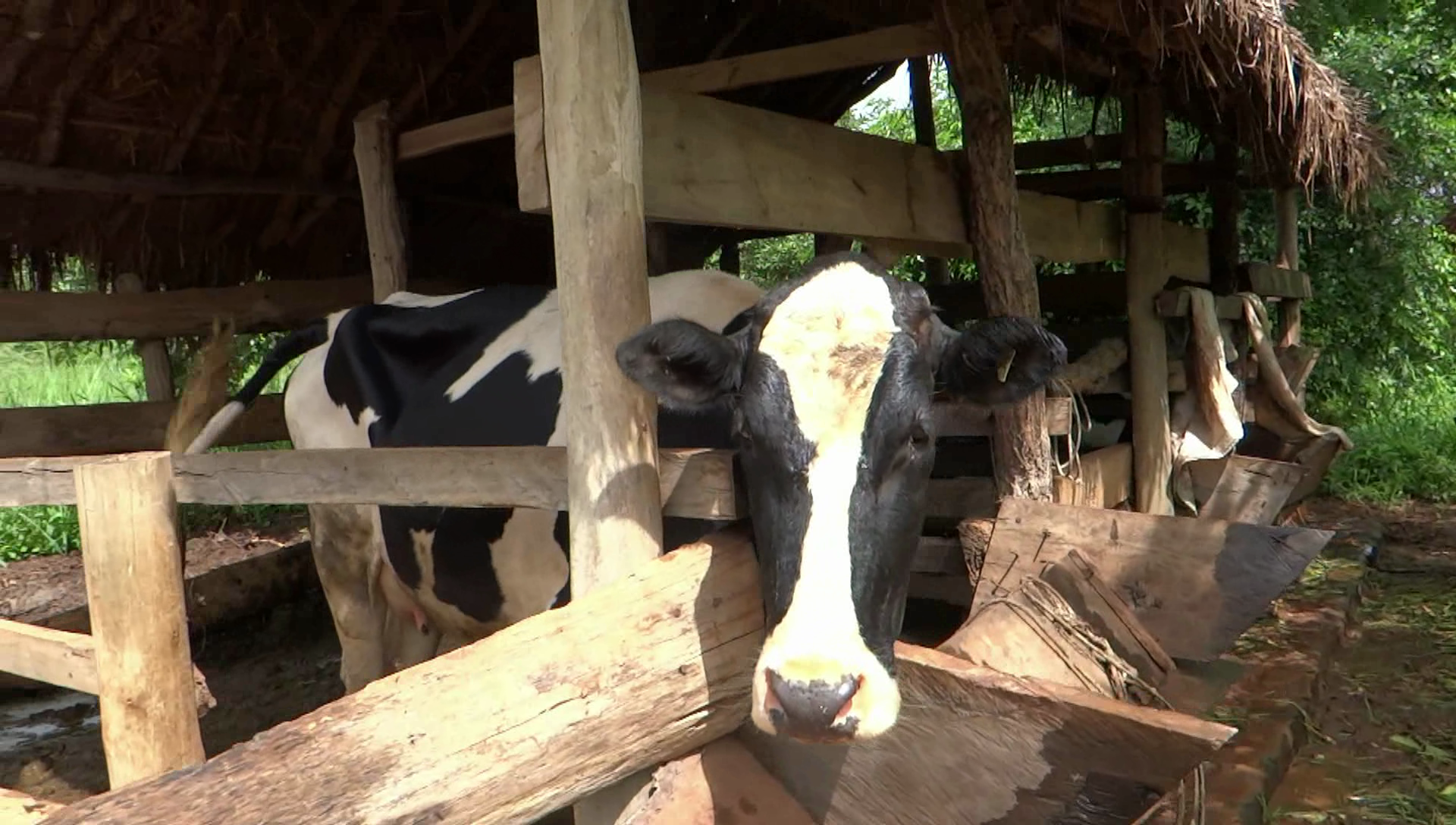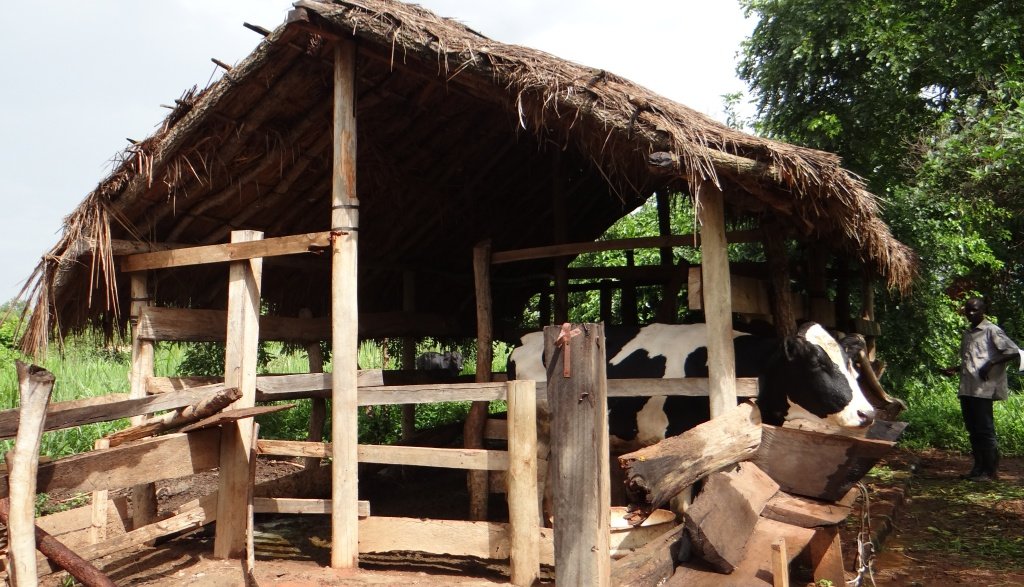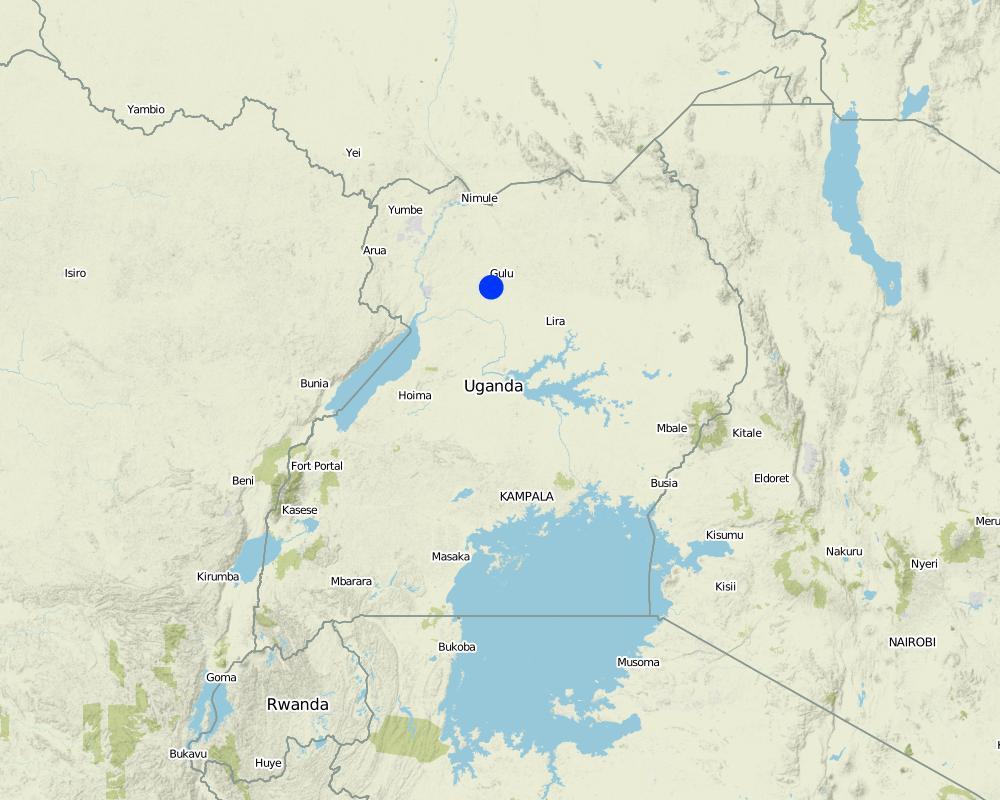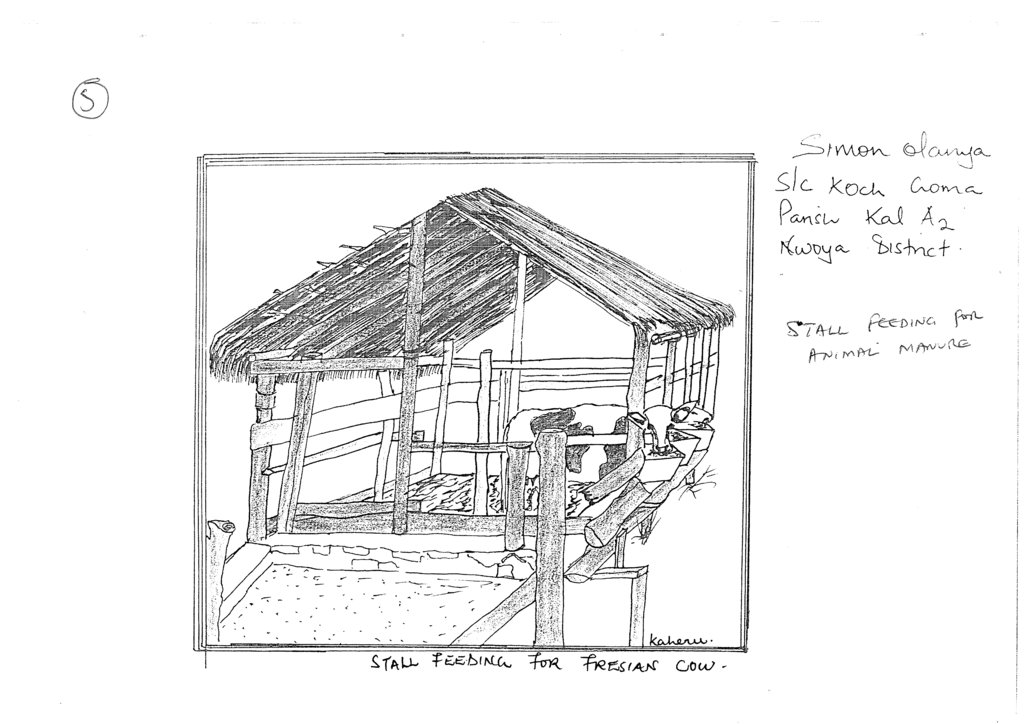Stall feeding of Friesian cow for manure [Uganda]
- Creation:
- Update:
- Compiler: Kamugisha Rick Nelson
- Editors: JOY TUKAHIRWA, Sunday Balla Amale, Richard Otto Kawawa, Bernard Fungo
- Reviewers: John Stephen Tenywa, Nicole Harari, Renate Fleiner, Stephanie Jaquet, Rima Mekdaschi Studer
Gokwo dyang
technologies_2816 - Uganda
- Full summary as PDF
- Full summary as PDF for print
- Full summary in the browser
- Full summary (unformatted)
- Stall feeding of Friesian cow by cut and carry for livestock management: July 16, 2018 (inactive)
- Stall feeding of Friesian cow by cut and carry for livestock management: March 22, 2019 (inactive)
- Stall feeding of Friesian cow by cut and carry for livestock management: Aug. 22, 2019 (public)
- Stall feeding of Friesian cow by cut and carry for livestock management: June 14, 2018 (inactive)
- Stall feeding of Friesian cow for manure: May 22, 2018 (inactive)
View sections
Expand all Collapse all1. General information
1.2 Contact details of resource persons and institutions involved in the assessment and documentation of the Technology
Key resource person(s)
land user:
Olanya Simon
0705255647
Farmer
Kosh village , Goma parish Unyona sub-county , Nwoya District
Uganda
land user:
Farmer
Kosh village , Goma parish Unyona sub-county , Nwoya district
Uganda
Name of project which facilitated the documentation/ evaluation of the Technology (if relevant)
Scaling-up SLM practices by smallholder farmers (IFAD)Name of the institution(s) which facilitated the documentation/ evaluation of the Technology (if relevant)
CDE Centre for Development and Environment (CDE Centre for Development and Environment) - Switzerland1.3 Conditions regarding the use of data documented through WOCAT
When were the data compiled (in the field)?
24/05/2017
The compiler and key resource person(s) accept the conditions regarding the use of data documented through WOCAT:
Yes
1.4 Declaration on sustainability of the described Technology
Is the Technology described here problematic with regard to land degradation, so that it cannot be declared a sustainable land management technology?
No
2. Description of the SLM Technology
2.1 Short description of the Technology
Definition of the Technology:
Dairy Animals are confined inside the stall, feed and water is provided for the animal. The systems is also referred to as zero grazing or cut and carry system of livestock management since the animals do not graze.
2.2 Detailed description of the Technology
Description:
In this practice, a Friesian cow and its calf are confined inside the built stall. The stall has four partitions. A Calf room, milking pallor, feeding and drinking area and sleeping room. Within the feeding area is placed a wooden box of width 0.5m, length 1.5m and height 0.3m; into which feed is put for the animal. A half drum that can hold 80 liters of water is also put inside the feeding area. Both the wooden feeder and half drum are raised to a height of 0.5m above the ground surface.
The farmer cultivated 1 acre of Napier grass (elephant grass), which provides adequate feed for the demands of the cow (75-100 kg of fresh grass per day). The Napier grass is cut, chopped and put inside the wooden box, while water is fetched from the stream and put into the half drum.
Through this method, the animal movement is restricted. This reduces the exposure to parasites and diseases, and land conflicts. The animal do not waste energy to look for pasture and water, hence milk productivity is enhanced. Manure is also deposited within the feeding area and thus easy to collect. Animals do not need to be attended to, hence farmer has more time to rest and carry out other activities.
However, a lot of labor is required for cutting and chopping the grass, and carrying the feeds and water especially during the dry season. Treatment of animals and maintenance of the stall is costly and due to poor management, parasites and diseases can also build up within the stall. Stall feeding requires feed preservation in the form of silage and/or hay.
To sustain this technology, the land users can supplement the feed through cultivating multipurpose tree species (Calliandra spp and Grivellia spp), leguminous forages such as lablab spp and macuna beans. Non conventional feeds such as kitchen wastes (cassava, sweet potato and banana peelings) can also supplement the pasture.
2.3 Photos of the Technology
2.4 Videos of the Technology
Comments, short description:
Video showing Stall feeding for fresian cow for animal manure
Date:
26/05/2017
Location:
Kosh village , Goma parish Unyona sub-county , Nwoya District
Name of videographer:
Issa Aiga
2.5 Country/ region/ locations where the Technology has been applied and which are covered by this assessment
Country:
Uganda
Region/ State/ Province:
Northern Region,Uganda
Comments:
Map showing the technology site in Northern Uganda
Map
×2.6 Date of implementation
Indicate year of implementation:
2014
If precise year is not known, indicate approximate date:
- less than 10 years ago (recently)
2.7 Introduction of the Technology
Specify how the Technology was introduced:
- through projects/ external interventions
Comments (type of project, etc.):
Do not know name of the project
3. Classification of the SLM Technology
3.1 Main purpose(s) of the Technology
- create beneficial economic impact
- livelihood restoration
3.2 Current land use type(s) where the Technology is applied

Grazing land
Intensive grazing/ fodder production:
- Cut-and-carry/ zero grazing
Main animal species and products:
Fresian cow, milk production, manure and calf
If land use has changed due to the implementation of the Technology, indicate land use before implementation of the Technology:
Cropland:ca
3.3 Further information about land use
Water supply for the land on which the Technology is applied:
- rainfed
Comments:
Use tap water from neighbour(brother) who pump under ground using generator.
Number of growing seasons per year:
- 2
Livestock density (if relevant):
cow =1 . calf =1
3.4 SLM group to which the Technology belongs
- integrated crop-livestock management
- integrated soil fertility management
- Stall feeding
3.5 Spread of the Technology
Specify the spread of the Technology:
- evenly spread over an area
3.6 SLM measures comprising the Technology

agronomic measures
- A2: Organic matter/ soil fertility

management measures
- M1: Change of land use type
- M2: Change of management/ intensity level

other measures
Comments:
Cut and carry
3.7 Main types of land degradation addressed by the Technology

chemical soil deterioration
- Cn: fertility decline and reduced organic matter content (not caused by erosion)
- Cs: salinization/ alkalinization

physical soil deterioration
- Pc: compaction
- Pu: loss of bio-productive function due to other activities
3.8 Prevention, reduction, or restoration of land degradation
Specify the goal of the Technology with regard to land degradation:
- reduce land degradation
4. Technical specifications, implementation activities, inputs, and costs
4.1 Technical drawing of the Technology
4.2 Technical specifications/ explanations of technical drawing
The stall should be 3 m tall, approximately with 4 rooms 1st floor for calf, second one for milking 3rd for sleeping and the 4th for feeding and drinking water
The Inputs required for this technology include: concrete wall built with cement, , wood (makonko), grass or iron roof, wooden box of about 1.5x0.5 m, half drum of about 80 litres both raised at 50cm above the floor
Slope: Gentle slope
4.3 General information regarding the calculation of inputs and costs
Specify how costs and inputs were calculated:
- per Technology area
Indicate size and area unit:
1.5 acres
other/ national currency (specify):
UGX
Indicate exchange rate from USD to local currency (if relevant): 1 USD =:
3724.89
Indicate average wage cost of hired labour per day:
5000
4.4 Establishment activities
| Activity | Type of measure | Timing | |
|---|---|---|---|
| 1. | Clearing and preparing land | Agronomic | During the first rainy season |
| 2. | Planting pasture | Agronomic | Once in a year(April-June) |
| 3. | Constructing stall | Structural | once before establsihment |
| 4. | Roofing | Structural | Once in a year |
| 5. | Concreting | Structural | once in year but keep repairing |
| 6. | Feeding and Providing water | Structural | Daily after establishment |
4.5 Costs and inputs needed for establishment
| Specify input | Unit | Quantity | Costs per Unit | Total costs per input | % of costs borne by land users | |
|---|---|---|---|---|---|---|
| Labour | labour | Persons | 74.0 | 5000.0 | 370000.0 | 70.0 |
| Labour | Hired | Persons | 14.0 | 5000.0 | 70000.0 | 30.0 |
| Equipment | Hoe | Pieces | 2.0 | 10000.0 | 20000.0 | 100.0 |
| Equipment | Panga | Pieces | 1.0 | 7000.0 | 7000.0 | 100.0 |
| Equipment | Spranger | Pieces | 1.0 | 10000.0 | 10000.0 | 100.0 |
| Plant material | Elephant grass | bundles | 5.0 | 100000.0 | 500000.0 | 100.0 |
| Plant material | lab lab | Pieces | 4.0 | 5000.0 | 20000.0 | 100.0 |
| Plant material | Bruchena | Pieces | 360.0 | 500.0 | 180000.0 | 100.0 |
| Plant material | Mucuna | Pieces | 1.0 | 20000.0 | 20000.0 | |
| Construction material | Timber | Pieces | 40.0 | 3000.0 | 120000.0 | 100.0 |
| Construction material | Cement | bags | 10.0 | 30000.0 | 300000.0 | 100.0 |
| Construction material | Logs | Pieces | 60.0 | 3000.0 | 180000.0 | 100.0 |
| Other | ||||||
| Other | Grass | bundles | 46.0 | 2000.0 | 92000.0 | |
| Total costs for establishment of the Technology | 1889000.0 | |||||
Comments:
Some seed like Macuna and brucheria was provided for free
4.6 Maintenance/ recurrent activities
| Activity | Type of measure | Timing/ frequency | |
|---|---|---|---|
| 1. | Weeding pasture | Agronomic | Three times per year |
| 2. | Repairing of stall | Structural | once after establishment and when need |
| 3. | Treatment of cow | Management | When need arises(sick) |
| 4. | Insemination | Agronomic | Once in two years |
| 5. | Spraying | Management | Twice per week |
4.7 Costs and inputs needed for maintenance/ recurrent activities (per year)
| Specify input | Unit | Quantity | Costs per Unit | Total costs per input | % of costs borne by land users | |
|---|---|---|---|---|---|---|
| Labour | Labour on daily basis | Persons | 2.0 | 5000.0 | 10000.0 | 70.0 |
| Labour | Hired labour on monthly basis | Persons | 1.0 | 150000.0 | 150000.0 | 30.0 |
| Equipment | Hoe | Pieces | 10.0 | 10000.0 | 100000.0 | 100.0 |
| Plant material | ||||||
| Plant material | Grass bundles | Bundles | 43.0 | 10000.0 | 430000.0 | |
| Total costs for maintenance of the Technology | 690000.0 | |||||
4.8 Most important factors affecting the costs
Describe the most determinate factors affecting the costs:
Treatment of diseases.
5. Natural and human environment
5.1 Climate
Annual rainfall
- < 250 mm
- 251-500 mm
- 501-750 mm
- 751-1,000 mm
- 1,001-1,500 mm
- 1,501-2,000 mm
- 2,001-3,000 mm
- 3,001-4,000 mm
- > 4,000 mm
Specify average annual rainfall (if known), in mm:
1500.00
Specifications/ comments on rainfall:
Two rainy season separated by about two weeks and dry spell and dry season of 4 weeks
Agro-climatic zone
- sub-humid
5.2 Topography
Slopes on average:
- flat (0-2%)
- gentle (3-5%)
- moderate (6-10%)
- rolling (11-15%)
- hilly (16-30%)
- steep (31-60%)
- very steep (>60%)
Landforms:
- plateau/plains
- ridges
- mountain slopes
- hill slopes
- footslopes
- valley floors
Altitudinal zone:
- 0-100 m a.s.l.
- 101-500 m a.s.l.
- 501-1,000 m a.s.l.
- 1,001-1,500 m a.s.l.
- 1,501-2,000 m a.s.l.
- 2,001-2,500 m a.s.l.
- 2,501-3,000 m a.s.l.
- 3,001-4,000 m a.s.l.
- > 4,000 m a.s.l.
Indicate if the Technology is specifically applied in:
- not relevant
5.3 Soils
Soil depth on average:
- very shallow (0-20 cm)
- shallow (21-50 cm)
- moderately deep (51-80 cm)
- deep (81-120 cm)
- very deep (> 120 cm)
Soil texture (topsoil):
- medium (loamy, silty)
Soil texture (> 20 cm below surface):
- fine/ heavy (clay)
Topsoil organic matter:
- medium (1-3%)
5.4 Water availability and quality
Ground water table:
5-50 m
Availability of surface water:
medium
Water quality (untreated):
good drinking water
Is water salinity a problem?
Yes
Is flooding of the area occurring?
No
5.5 Biodiversity
Species diversity:
- low
Habitat diversity:
- low
5.6 Characteristics of land users applying the Technology
Sedentary or nomadic:
- Sedentary
Market orientation of production system:
- mixed (subsistence/ commercial
Off-farm income:
- less than 10% of all income
Relative level of wealth:
- average
Individuals or groups:
- individual/ household
Level of mechanization:
- manual work
- mechanized/ motorized
Gender:
- women
- men
Age of land users:
- youth
- middle-aged
5.7 Average area of land owned or leased by land users applying the Technology
- < 0.5 ha
- 0.5-1 ha
- 1-2 ha
- 2-5 ha
- 5-15 ha
- 15-50 ha
- 50-100 ha
- 100-500 ha
- 500-1,000 ha
- 1,000-10,000 ha
- > 10,000 ha
Is this considered small-, medium- or large-scale (referring to local context)?
- medium-scale
Comments:
Inherited land
5.8 Land ownership, land use rights, and water use rights
Land ownership:
- individual, not titled
Land use rights:
- individual
Water use rights:
- communal (organized)
5.9 Access to services and infrastructure
health:
- poor
- moderate
- good
education:
- poor
- moderate
- good
technical assistance:
- poor
- moderate
- good
employment (e.g. off-farm):
- poor
- moderate
- good
markets:
- poor
- moderate
- good
energy:
- poor
- moderate
- good
roads and transport:
- poor
- moderate
- good
drinking water and sanitation:
- poor
- moderate
- good
financial services:
- poor
- moderate
- good
6. Impacts and concluding statements
6.1 On-site impacts the Technology has shown
Socio-economic impacts
Production
crop production
Comments/ specify:
Using manure from the stall.
fodder production
Comments/ specify:
0.5 acre improved pasture but lack management.
animal production
Quantity before SLM:
3 litres of milk per day
Quantity after SLM:
10litres of milk per day
Comments/ specify:
Increased milk production.
production area
Comments/ specify:
Additional fodder.
land management
Comments/ specify:
Ggrowing of fodder trees.
Water availability and quality
water quality for livestock
Comments/ specify:
But has had no much effect.
Income and costs
expenses on agricultural inputs
Comments/ specify:
Planting material
farm income
Comments/ specify:
Sale of milk.
diversity of income sources
Comments/ specify:
More products for sale (grass, milk, manure).
workload
Comments/ specify:
Feeding animal.
Socio-cultural impacts
food security/ self-sufficiency
Comments/ specify:
Income received from sale of milk is used for buying food.
community institutions
Comments/ specify:
Especially in savings and credit (SACCO).
Ecological impacts
Soil
soil loss
Comments/ specify:
Restricted movements of cattle.
soil compaction
Comments/ specify:
Less tampering with the soil.
nutrient cycling/ recharge
Comments/ specify:
Manure and fallowing.
soil organic matter/ below ground C
Comments/ specify:
Due to application of manure.
6.2 Off-site impacts the Technology has shown
damage on neighbours' fields
Comments/ specify:
No zero grazing
impact of greenhouse gases
Comments/ specify:
No bio gas production
6.3 Exposure and sensitivity of the Technology to gradual climate change and climate-related extremes/ disasters (as perceived by land users)
Comments:
The land user requires more knowledge and skills for sustainability of this technology
6.4 Cost-benefit analysis
How do the benefits compare with the establishment costs (from land users’ perspective)?
Short-term returns:
negative
Long-term returns:
very positive
How do the benefits compare with the maintenance/ recurrent costs (from land users' perspective)?
Short-term returns:
negative
Long-term returns:
very positive
Comments:
Very difficult to put all the money in this investment.
6.5 Adoption of the Technology
- 1-10%
Of all those who have adopted the Technology, how many have did so spontaneously, i.e. without receiving any material incentives/ payments?
- 0-10%
Comments:
Motivated by NGO.
6.6 Adaptation
Has the Technology been modified recently to adapt to changing conditions?
Yes
If yes, indicate to which changing conditions it was adapted:
- climatic change/ extremes
Specify adaptation of the Technology (design, material/ species, etc.):
During the dry season, the land user seek fodder from the swamps.
6.7 Strengths/ advantages/ opportunities of the Technology
| Strengths/ advantages/ opportunities in the land user’s view |
|---|
| The technology is good at providing income for household needs. |
| The technology is replicable in other areas and helps diversify income source because of the many products derived from the technology. |
| Does not require labour to attend to it for 12 hours in a day unlike those technologies that concern cultivation. This means the farmer has more time to do other activities in a day. |
| Strengths/ advantages/ opportunities in the compiler’s or other key resource person’s view |
|---|
| Appropriate for low maintenance costs. |
| The technology does not promote conflicts among land users. |
6.8 Weaknesses/ disadvantages/ risks of the Technology and ways of overcoming them
| Weaknesses/ disadvantages/ risks in the land user’s view | How can they be overcome? |
|---|---|
| High costs of treatment. | Reduce risk of infection and infestation. |
| Veterinary services expensive and not easily available. | Training of local trainers to support extension. |
| Weaknesses/ disadvantages/ risks in the compiler’s or other key resource person’s view | How can they be overcome? |
|---|---|
| The technology is not sustainable if not well manged by the land user. | Improve management of the technology. |
| Requires day to day monitoring of diseases. | Engage household labour to keep alternating. |
| The land user does not provide concentrates to the technology. | Train the land user on how to make concentrates. |
7. References and links
7.1 Methods/ sources of information
- field visits, field surveys
01
- interviews with land users
01
Links and modules
Expand all Collapse allLinks
No links
Modules
No modules







